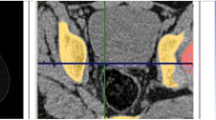Abstract
Purpose
Understanding acetabular orientation is important in many orthopaedic procedures. Acetabular orientation, usually described by anteversion and abduction angles, has uncertain measurement variability in adult patients. The goals of this study are threefold: (1) to describe a new method for computing patient-specific abduction/anteversion angles from a single CT study based on the identification of anatomical landmarks and acetabular rim points; (2) to quantify the inaccuracies associated with landmark selection in computing the acetabular angles; and (3) to quantify the variability and symmetry of acetabular orientation.
Methods
A total of 25 CT studies from adult patients scanned for non-orthopaedic indications were retrospectively reviewed. The patients were randomly selected from the hospital’s database. Inclusion criteria were adults 20–65 years of age. Acetabular landmark coordinates were identified by expert observers and tabulated in a spreadsheet. Two sets of calculations were done using the data: (1) computation of the abduction and anteversion for each patient, and (2) evaluation of the variability of measurements in the same individual by the same surgeon. The results were tabulated and summary statistics computed.
Results
This retrospective study showed that acetabular abduction and anteversion angles averaged 54° and 17°, respectively, in adults. A clinically significant intra-patient variability of >20° was found. We also found that the right and left side rim plane orientation were significantly correlated, but were not always symmetric.
Conclusion
A new method of computing patient-specific abduction and anteversion angles from a CT study of the anterior pelvic plane and the left and right acetabular rim planes was reliable and accurate. We found that the acetabular rim plane can be reliably and accurately computed from identified points on the rim. The novelty of this work is that angular measurements are performed between planes on a 3-D model rather than lines on 2-D projections, as was done in the past.
Similar content being viewed by others
References
Murray D (1993) The definition and measurement of acetabular orientation. J Bone Joint Surg Br 75-B(2): 228–232
Rab GT (2007) Lateral acetabular rotation improves anterior hip subluxation. Clin Orthop Relat Res 456: 170–175
Tonnis D, Heinecke A (1999) Acetabular and femoral anteversion: relationship with osteoarthritis of the hip. J Bone Joint Surg Am 81(12): 1747–1770
Banks KP, Grayson DE (2007) Acetabular retroversion as a rare cause of chronic hip pain: recognition of the “figure-eight” sign. Skeletal Radiol 36(1): S108–S111
Reikeras O, Bjerkreim I, Kolbenstvedt A (1982) Anteversion of the acetabulum in patients with idiopathic increased anteversion of the femoral neck. Acta Orthop Scand 53(6): 847–852
Anda S, Svenningsen S, Grontvedt T, Benum P (1990) Pelvic inclination and spatial orientation of the acetabulum. A radiographic, computed tomographic and clinical investigation. Acta Radiol 31(4): 389–394
Muller O, Reize P, Trappmann D, Wulker N (2006) Measuring anatomical acetabular cup orientation with a new X-ray technique. Comput Aided Surg 11(2): 69–75
Tallroth K, Lepisto J (2006) Computed tomography measurement of acetabular dimensions: normal values for correction of dysplasia. Acta Orthop 77(4): 598–602
Anda S, Svenningsen S, Dale LG, Benum P (1986) The acetabular sector angle of the adult hip determined by computed tomography. Acta Radiol Diagn (Stockh) 27(4): 443–447
Anda S, Terjesen T, Kvistad KA (1991) Computed tomography measurements of the acetabulum in adult dysplastic hips: which level is appropriate. Skeletal Radiol 20(4): 267–271
Nagao Y, Aoki H, Ishii SJ, Masuda T, Beppu M (2008) Radiographic method to measure the inclination angle of the acetabulum. J Orthop Sci 13(1): 62–71
Kohnlein W, Ganz R, Impellizzeri FM, Leunig M (2009) Acetabular morphology: implications for joint-preserving surgery. Clin Orthop Relat Res 467(3): 682–691
Stem ES, O’Connor MI, Kransdorf MJ, Crook J (2006) Computed tomography analysis of acetabular anteversion and abduction. Skeletal Radiol 35(6): 385–389
Abel MF, Sutherland DH, Wenger DR, Mubarak SJ (1994) Evaluation of CT scans and 3-D reformatted images for quantitative assessment of the hip. J Pediatr Orthop 14(1): 48–53
Murtha PE, Hafez MA, Jaramaz B, DiGioia AM III (2008) Variations in acetabular anatomy with reference to total hip replacement. J Bone Joint Surg Br 90(3): 308–313
Grutzner PA, Zheng G, Langlotz U, von Recum J, Nolte LP, Wentzensen A et al (2004) C-arm based navigation in total hip arthroplasty-background and clinical experience. Injury 35(1): S-A90–S-A95
Jaramaz B, DiGioia AM III, Blackwell M, Nikou C (1998) Computer assisted measurement of cup placement in total hip replacement. Clin Orthop Relat Res 354(354): 70–81
Wolf A, Digioia AM 3rd, Mor AB, Jaramaz B (2005) Cup alignment error model for total hip arthroplasty. Clin Orthop Relat Res (437): 132–137
Olivecrona H, Weidenhielm L, Olivecrona L, Beckman MO, Stark A, Noz ME et al (2004) A new CT method for measuring cup orientation after total hip arthroplasty: a study of 10 patients. Acta Orthop Scand 75(3): 252–260
Boulay C, Tardieu C, Benaim C, Hecquet J, Marty C, Prat-Pradal D et al (2006) Three-dimensional study of pelvic asymmetry on anatomical specimens and its clinical perspectives. J Anat 208(1): 21–33
Author information
Authors and Affiliations
Corresponding author
Rights and permissions
About this article
Cite this article
Lubovsky, O., Peleg, E., Joskowicz, L. et al. Acetabular orientation variability and symmetry based on CT scans of adults. Int J CARS 5, 449–454 (2010). https://doi.org/10.1007/s11548-010-0521-9
Received:
Accepted:
Published:
Issue Date:
DOI: https://doi.org/10.1007/s11548-010-0521-9




